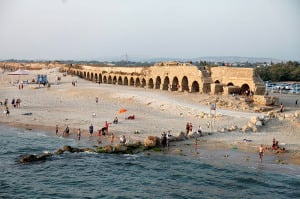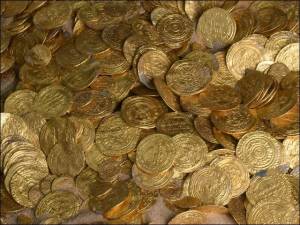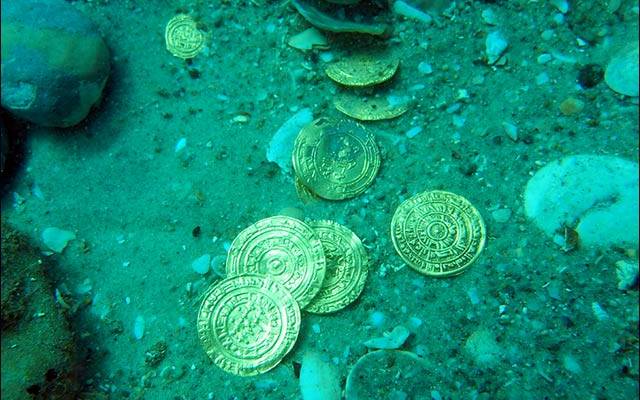While Israel’s hidden treasures never cease to amaze, the latest find provided a golden opportunity for divers and archaeologists alike.

The ruins of the ancient port city of Caesarea. (Photo: Moshe Shai/Flash90).
A treasure containing some 2,000 gold coins, the largest trove of its kind found in Israel to date, was recently discovered on the seabed of the ancient harbor in Caesarea, announced the Israel Antiquities Authority (IAA) on Tuesday.
Members of a local diving club were exploring the harbor when they came across the lost fortune. While they initially thought they had spotted a toy coin from a game, they quickly understood the coin was “the real thing” after they collected several more and returned to the shore to inform the director of the dive club about their find. He relayed the discovery to the Marine Archaeology Unit of the IAA.
Using a metal detector, the full dimensions of the trove were revealed. The treasure includes gold coins in different denominations, including dinars, half dinars and quarter dinars of various dimensions and weights, most of them from the period of the Fatimid caliphs (996 – 1036 CE).
Kobi Sharvit, director of the Marine Archaeology Unit of the IAA, called this find fascinating and rare historical evidence of life in the past, which was exposed during winter storms. “The discovery of such a large hoard of coins that had such tremendous economic power in antiquity raises several possibilities regarding its presence on the seabed. There is probably a shipwreck there of an official treasury boat which was on its way to the central government in Egypt with taxes that had been collected. Perhaps the treasure of coins was meant to pay the salaries of the Fatimid military garrison which was stationed in Caesarea and protected the city.”
Another theory is that the money belonged to a large merchant ship that sank there while trading with coastal cities and Mediterranean ports.
The Fatimid dynasty’s rise to power in the tenth century CE brought political and economic policies that renewed growth in the eastern Mediterranean basin’s maritime trade. The Fatimids, who came from North Africa, brought trading practices to Egypt which were characteristic of the western Mediterranean Sea. Under their rule, Caesarea and other coastal cities were developed.
The IAA will supplement their understanding of the archaeological context through salvage excavations to resolve many unanswered questions about the treasure.
Robert Cole, a coin expert with the IAA, remarked, “The coins are in an excellent state of preservation, and despite the fact they were at the bottom of the sea for about a thousand years, they did not require any cleaning or conservation intervention from the metallurgical laboratory. This is because gold is a noble metal and is not affected by air or water.”
Several of the coins that were found in the assemblage were bent and exhibit teeth and bite marks, evidence they were “physically” inspected by their owners or the merchants. Other coins bear signs of wear and abrasion from use, while others seem as though they were just minted.
Exemplary Citizens

The rare treasure. (Photo: Clara Amit/IAA)
Sharvit characterized the divers who uncovered the treasure as “model citizens” with “heart[s] of gold” who “love[] the country and its history.” The treasure is estimated to be worth millions.
Sharvit added:
“The Law of Antiquities states that all antiquities belong to the state and that not reporting or removing antiquities from their location, or selling or trading them is an offense punishable by up to five years imprisonment. In this case the divers reported the find; but in many instances divers take the objects home and that way extremely important archaeological information is lost forever. Therefore the discovery of the treasure underscores the need to combine the development of the place as a tourism and diving site with restrictions that will allow the public to dive there only when accompanied by inspectors or instructors from the diving club”.
The Caesarea Development Company and Nature and Parks Authority welcomed the discovery of the treasure. According to the Authority, “There is no doubt that the discovery of the impressive treasure highlights the uniqueness of Caesarea as an ancient port city with rich history and cultural heritage. After 2,000 years it is still capable of captivating its many visitors, of continuing to innovate and surprise again when other parts of its mysterious past are revealed in the ground and in the sea.”
By: United with Israel Staff

Free Ebook: 10 Best Places to Visit in Israel
The Land of Israel has provided the backdrop for some of the most important events in human history. From the Old City in Jerusalem to the Sea of Galilee, people from all over the globe visit the Holy Land each year to take in the breathtaking scenery and inspiration of Israel. Now you can experience this beauty for yourself from the comforts of home and maybe plan a trip of your own to Israel. Get the free, exclusive eBook from United with Israel: The 10 Best Places to Visit in Israel.
